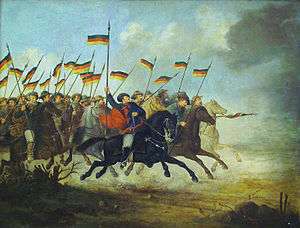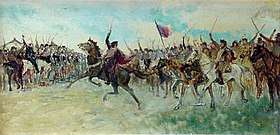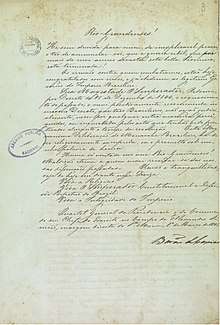Ragamuffin War
| Ragamuffin War | |||||||
|---|---|---|---|---|---|---|---|
 Charge of the Cavalry by Guilherme Litran depicting the Riograndense army. | |||||||
| |||||||
| Belligerents | |||||||
|
| |||||||
| Commanders and leaders | |||||||
| |||||||
| Strength | |||||||
| 10,000 soldiers[1] | 20,000 soldiers[1] | ||||||
| Casualties and losses | |||||||
| 3,000 killed[1] | |||||||
The Ragamuffin War (Portuguese: Guerra dos Farrapos or, more commonly Revolução Farroupilha) was a Republican uprising that began in southern Brazil, in the province (currently state) of Rio Grande do Sul in 1835. The rebels, led by generals Bento Gonçalves da Silva and Antônio de Sousa Neto with the support of the Italian fighter Giuseppe Garibaldi, surrendered to imperial forces in 1845.[2]
It is considered the longest and third bloodiest of the failed wars of secession in the Brazilian Empire, after the Cabanagem Revolt and Balaiada Revolt.
History
Beginning of the war
The uprising is believed to have begun due to the difference between the economy of Rio Grande do Sul and the rest of the country. Unlike the other provinces, the economy of Rio Grande do Sul focused on the internal market rather than exporting commodities. The province's main product, charque (dried and salted beef), suffered badly from competition from charque imported from Uruguay and Argentina. The people that benefited from these markets were called "Gauchos," nomadic cowhands and farmers who lived in Rio Grande do Sul.[3] The Gauchos also lived in Argentina and Uruguay.[3]
In 1835, Antônio Rodrigues Fernandes Braga was nominated president of Rio Grande do Sul and at first, his appointment pleased the liberal farmers, but that soon changed. In his first day in the office, he accused many farmers of being separatists.
On 20 September 1835, General Bento Gonçalves captured the capital, Porto Alegre, beginning an uprising against the perceived unfair trade reinforced by the provincial government. The provincial president fled to the city of Rio Grande, 334 km (208 mi) to the south. In Porto Alegre, the rebels, also known as "ragamuffins" (farrapos) after the fringed leather worn by the gauchos,[2] elected Marciano José Pereira Ribeiro their new president. Responding to the situation and further upsetting the rebels, the Brazilian regent, Diogo Antônio Feijó, appointed a new provincial president, who was forced to take office in exile in Rio Grande.
Declaration of independence


Pushing to consolidate their power, Antônio de Souza Neto declared the independence of the Riograndense or Piratini Republic on 11 September 1836, with Bento Gonçalves as president nominee. However, Gonçalves was arrested and jailed by imperial forces until he escaped in 1837, returning to the province and bringing the revolution to a head. Nonetheless, Porto Alegre was recaptured by the empire and the rebels never managed to regain it. In Bahia, there was another revolt called the Sabinada Revolt in 1837.[4] They managed to create another Republic but it fell quickly within 4 months.[4] The Brazilian Army had a number of problems at the time and were not able to handle the secessionist threat.[5] Through military reforms, the mass recruitment of civilians was made possible and they were able to quell the rebels in 1845.[5]
The Italian revolutionary Giuseppe Garibaldi joined the rebels in 1836. With his help, the revolution spread north through Santa Catarina, which adjoined Rio Grande do Sul. One of the main cities of Santa Catarina, Laguna, was taken by the rebels but fell back into imperial hands after four months. It was in this struggle that Garibaldi gained his first military experience and got on the road leading to his becoming the famed military leader of the Unification of Italy.[6] The rebel forces were also aided financially and indirect military support by the Uruguayan government led by José Fructuoso Rivera.[4] The Uruguayans had the intention of creating a political union with the Riograndense Republic to create a new stronger state.[4]
Resultant peace
The rebels refused an offer of amnesty in 1840. In 1842, they issued a Republican constitution as a last attempt to maintain power. The same year saw General Lima e Silva take command of Imperial forces in the area, and try to negotiate a settlement.

On 1 March 1845, the peace negotiations led by Lima e Silva and Antônio Vicente da Fontoura concluded with the signing of the Ponche Verde Treaty between the two sides, in Dom Pedrito. The treaty offered the rebels a full amnesty, full incorporation into the imperial army and the choice of the next provincial president. All the debts of the Riograndense Republic were paid off by the Empire and a tariff of 25% was introduced on imported charque. The Riograndense and Juliana Republics remained in the Empire of Brazil and are now two states of the Federative Republic of Brazil, Rio Grande do Sul and Santa Catarina respectively.
As a goodwill gesture, the rebels chose Lima e Silva as the next provincial president.
Legacy
The Brazilian Army reorganized itself to be a proper fighting force during the Ragamuffin War.[5] The military would be able to defeat insurgencies that rose up during the Imperial Era of Brazil. However, this reformed military would prove disastrous against the Emperor when they rebelled to create a Republic.
Popular culture
- Anita e Garibaldi, a 2013 Brazilian film, follows the arrival of Giuseppe Garibaldi in Brazil, his meeting with Anita Garibaldi and the human and military learning with Luigi Rossetti during the Ragamuffin War. [7]
- Brazil soap opera “A Casa Das Sete Mulheres”
See also
- List of wars involving Brazil
- Revolutions of Brazil
References
- Treece, Dave (2000). Exiles, Allies, Rebels. Greenwood Publishing Group. ISBN 9780313311253. ("Brazil's Indianist Movement, Indigenist Politics, and the Imperial Nation-state").
- Loveman, Brian (1999). For La Patria: Politics and the Armed Forces in Latin America (illustrated ed.). Rowman & Littlefield. p. 43. ISBN 978-0-8420-2773-1.
- Britannica, Editors of. "Gaucho, South American History". Encyclopedia Britannica. Encyclopedia Britannica. Retrieved 11 April 2018.CS1 maint: extra text: authors list (link)
- Bak, Joan (2008). Encyclopedia of Latin American Studies and Culture. Charles Scribners Sons. p. 186.
- Riberio, Jose (Dec 2011). "The Strengthening of the Imperial State through Military Recruitment in the Context of the Farrapos War". scielo.br.
- Trevelyan, George Macaulay (1907-01-01). Garibaldi's defence of the Roman Republic. London, New York [etc.] : Longmans, Green and Co.
- http://www.ancine.gov.br/brasil-nas-telas/anita-e-garibaldi
External links
| Wikimedia Commons has media related to War of Tatters. |
.svg.png)